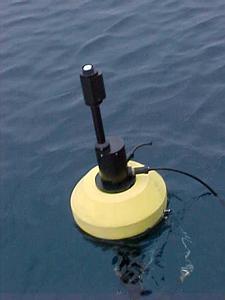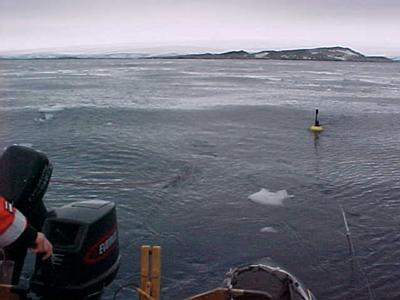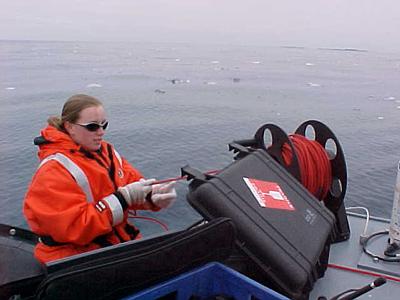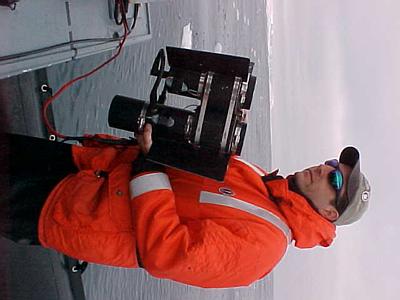11 April, 2000
LTER Phytoplankton Group; Part 3
Question 52: Does Antarctica have any mountains?
Continued from 4/10...
The LTER group is looking at phytoplankton because it is the base of the food
web here. Phytoplankton doesn't eat; it produces its own food. Krill and
other zooplankton eat phytoplankton. In turn, they support the large animals
of the area. Based on the amount of time each water sample takes to filter,
there are many fewer phytoplankton lower in the water column. The bloom has
ended now. The last two days the group went out on Bruiser there was nothing
in the water. The field season is set up to encompass the bloom, from early
November to the end of March.
Besides the photosynthetic rate experiments, the LTER group also looks at the
chemistry of the water and some of its bio-optic properties. The CTD
instrument pack they deployed from Bruiser has instruments that measure water
temperature, conductivity, density and depth. Data is collected from
satellite observations and automatic weather stations to assist in prediction
of sea-ice formation: sea ice extent, sea surface temperatures, ozone
concentration, ocean color, cloud coverage and basic weather statistics. The
LTER has automatic weather stations on three islands on the Antarctic
Peninsula.
Part of the work the group was doing during March was a comparison of two
light-intensity measuring buoys. Natacha Bernier was involved with this; she
came down from Dalhousie University in Halifax, Nova Scotia. She is currently
working towards her masters in oceanography, and their degree program requires
a certain amount of field research time. Natacha says she likes the equality
of Palmer, for example, staff and science clean the kitchen and station
together. Also, Antarctica is a place she has always wanted to go.
Both buoys record light intensity in the water column compared to light
intensity at the surface. Visible light wave lengths are in the range of
400-770 nm (nanometers). In the metric scale micro is 1000 times smaller than
milli, and nano is 1000 times smaller than micro. The buoys record the light
intensity at each wave length band or channel. The buoy Natacha was sent down
to test measures 256 channels. Kirk's buoy, that the LTER has been using,
measures only 13 channels but does have a profiler that shows how light
changes with depth. In water with phytoplankton, light is lost more quickly.
Natacha's buoy was modified to work off several 12-volt batteries, but would
need still more power to profile (the downside of her buoy is that it is a
power hog). Water absorbs red light and phytoplankton absorb blue light; so,
the more phytoplankton, the greener the ocean. By measuring the light
intensities along the visible light spectrum both at the surface and in the
water column, the buoys tell the group how much energy is available for
phytoplankton and how much phytoplankton is present.
We had to abort our dive today. At lunch there was a brief window when the
wind went down. We rushed into our gear and took the boat out towards DeLaca
Island. Part way out, the wind started to pick up again, no treat with large
waves blowing into your face! By the time we got to the site and started
donning our gear, it was hard to stand in the boat because of the swells.
Several of our group (including the tender from the station) are prone to
seasickness, and we were all feeling miserable. We didn't call off the dive
until we were fully in our gear and it had started to sleet on us. Katrin and
I lay on the floor of the boat with tanks, masks, fins and BCs on all the way
back to the station. The winds had picked up to 35 knots while we were out.
Answer 51: The coldest temperature recorded in Antarctica (and in the world!)
was -89.2 degrees C (-128.6 degrees F) at Vostok, one of the Russian bases, in
July 1983.

Gentoo penguin feeding near us at Station E.

Natacha's buoy in the water, the ambient surface light sensor is the white button on top.

Both buoys deployed behind Bruiser connected with towing cable and computer cable. Both send information to laptop computers kept on board Bruiser.

Meg cranking the buoy cable back in to the boat.

Kirk's light intensity sampling buoy. The light sensors are the white buttons. The ambient surface light sensors are attached to the grey box on Bruiser to the left.

Kirk lowering CTD instrument bundle with Bruiser's winch.

Natacha's light intensity measuring buoy.

Contact the TEA in the field at
.
If you cannot connect through your browser, copy the
TEA's e-mail address in the "To:" line of
your favorite e-mail package.
|
